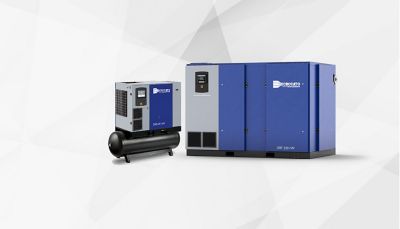Humidity in the ambient air turns into moisture during the compression process and it can damage the compressed air system. Removing moisture from compressed air is mandatory to protect your production system. Installing a desiccant dryer helps to remove moisture, drying compressed air and keeping your production running smoothly.
To better understand a desiccant air dryer, we will dive deep into what is it, its working principle and applications.
What is a air compressor Desiccant Dryer?
A desiccant dryer, or an adsorption dryer, is a device that removes moisture from compressed air using a specific desiccant material. This material can absorb moisture from the air, dries compressed air and is suitable for various industrial applications.
Desiccant dryers are particularly useful when extremely dry air is required. Some examples are laboratories, spray painting, and printing.
Desiccant Materials
Adsorption dryers use several types of desiccant material. Their optimal performance varies according to the dew point. Ceccato uses the following desiccant materials:
Activated Alumina: this material is a highly porous material that can absorb a significant amount of moisture. Activated alumina has a high adsorption capacity and durability. This material offers great performance when the PDP is superior or equal to -40°C.
Silica Gel: silica gel is a desiccant material known for its high moisture absorption capacity. It is recommended with a PDP between -40° and -60°C. Despite its low mechanical features, the amount of water that silica gel can absorb is 40% of its mass.
Molecular Sieves: molecular sieves are synthetic desiccants with uniform pore sizes that can selectively adsorb specific molecules. They perform at their best when the dew point is -70°C. For this reason, molecular sieves are suitable for applications with a extremely low dew point. This desiccant material is adapt also when the air temperature reaches 40-40°C.
These three types of desiccant material are inert to the gas and they offer a great mechanical consistency. They can absorb water without changing their chemical structure. In general, they can last for 5 years of continuous usage.
 A desiccant dryer, or an adsorption dryer, removes moisture from compressed air through desiccant material.
A desiccant dryer, or an adsorption dryer, removes moisture from compressed air through desiccant material.
How Desiccant Dryers Work
The drying process of a desiccant air dryer involves two tower filled with the desiccant material. Adsorption dryers attract and hold the moisture using the desiccant material.
Compressed air flows in one tower, where the desiccant absorbs moisture, resulting in dry air. Meanwhile, the other tower starts the regeneration phase, when the adsorbed moisture is removed from the desiccant material. The system switches between the two towers to ensure a continuous supply of dry air..
Applications of an Air compressor Desiccant Dryer
An air compressor desiccant dryer is used in various industries to ensure the quality of compressed air. Some common applications include:
- Pharma industry: Maintaining sterile environments and preventing contaminants.
- Food and Beverage: Ensuring product quality and preventing spoilage.
- Automotive: Enhancing the performance of pneumatic tools and equipment.
- Electronics: Preventing moisture-related damage to sensitive components.
Maintenance and Lifespan of Desiccant Dryers
The lifespan of desiccant dryers depends on factors such as the type of dryer, application, and maintenance level. For example, activated alumina desiccant can last up to 5 years in heatless dryers with proper maintenance. In heat-regenerated dryers, the same material lasts 2 to 3 years.
Regular inspections and replacement of desiccant are crucial to ensuring its longevity.
Monitoring the desiccant's performance through pressure drop measurements, moisture content analysis, and visual inspection is important for maintenance.
How to choosing the Right Desiccant Dryer
When choosing the right desiccant dryer, you should consider several factors, such as the need dew point and the compressed air demand.
Heatless desiccant dryers are suitable for low-level compressed air demand. Heated and blower purge dryers, instead, are ideal for higher demands and applications requiring extremely dry air.
For a proper selection, consulting the experts is always a good idea. They can go through all your needs and provide the most suitable solution.
Common Questions About Desiccant Dryers
How long does desiccant last in a dryer?
Desiccant lifespan varies based on factors such as the type of dryer, application, and maintenance level. To grant the longest lifespan to your machine, you should follow the experts suggestions and the producers' guidelines.
How often should desiccant be replaced in a dryer?
The frequency of replacing the desiccant material varies according to the dryers usage and the ambient humidity. Regular inspections can help to understand when changing the desiccant material.
What factors affect the lifespan of desiccant in a dryer?
Operating conditions, compressed air quality, dryer system efficiency, and the specific desiccant material used are factors that can affect the lifespan of desiccant in a dryer.
How can I monitor the performance of desiccant in a dryer?
Monitoring the desiccant's performance through methods like pressure drop measurements, moisture content analysis, and visual inspection can help assess its condition and ensure proper maintenance.
Where can I find specific instructions on desiccant maintenance for my dryer system?
Consulting the dryer system's manufacturer or referring to the specific product documentation is recommended for precise instructions on desiccant maintenance, replacement, and lifespan to ensure efficient operation of the dryer system.
Learn everything on a Desiccant Dryer with a Ceccato Expert
Desiccant dryers play a vital role in maintaining the quality of compressed air in industrial settings. By removing excess moisture, they protect equipment, prevent product contamination, and ensure efficient operation.
If you invest in a reliable desiccant dryer and follow proper maintenance, you can ensure the longevity and efficiency of your compressed air system.
Get in touch with the expert to learn more on desiccant air dyers.






